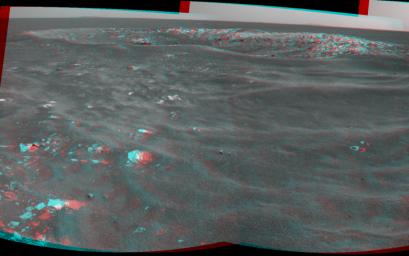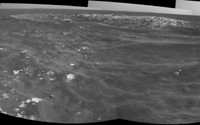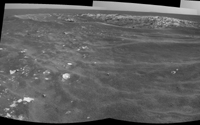
|
Martian ‘Freedom 7’ Crater 50 Years After Freedom 7 Flight (Stereo)
- Click the image above for a larger view
- Full-Res JPEG (1747 x 1093) (245.7 kB)
- Full-Res TIFF (1747 x 1093) (5.7 MB)
Caption:
|
Click on an individual image for full resolution figures image
NASA's Mars Exploration Rover Opportunity recorded this stereo view of a crater informally named "Freedom 7" shortly before the 50th anniversary of the first American in space: astronaut Alan Shepard's flight in the Freedom 7 spacecraft.
The image combines four frames that Opportunity took with its navigation camera during the 2,585th Martian day, or sol, of the rover's work on Mars (May 2, 2011). Shepard's suborbital flight lasted 15 minutes on May 5, 1961. Two of the frames come from the camera's left eye, the other two from its right eye. The scene appears three dimensional when viewed through red-blue glasses with the red lens on the left.
The crater is about 25 meters (82 feet) in diameter. It is the largest of a cluster of about eight craters all formed just after an impactor broke apart in the Martian atmosphere.
By taking advantage of seeing many craters of diverse ages during drives between major destinations, the Opportunity mission is documenting how impact craters change with time. The cluster that includes Freedom 7 crater formed after sand ripples in the area last migrated, which is estimated to be about 200,000 years ago.
Background Info:
NASA's Jet Propulsion Laboratory, a division of the California Institute of Technology in Pasadena, manages the Mars Exploration Rover Project for the NASA Science Mission Directorate, Washington.
Cataloging Keywords:
| Name | Value | Additional Values |
|---|---|---|
| Target | Mars | |
| System | ||
| Target Type | Planet | |
| Mission | Mars Exploration Rover (MER) | |
| Instrument Host | Opportunity (MER-B) | |
| Host Type | Rover | |
| Instrument | Navigation Camera (Navcam) | |
| Detector | ||
| Extra Keywords | Atmosphere, Color, Crater, Impact | |
| Acquisition Date | ||
| Release Date | 2011-05-04 | |
| Date in Caption | 1961-05-05 | 2011-05-02 |
| Image Credit | NASA/JPL-Caltech | |
| Source | photojournal.jpl.nasa.gov/catalog/PIA13989 | |
| Identifier | PIA13989 | |


